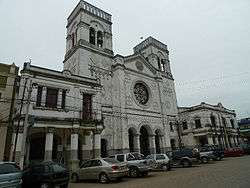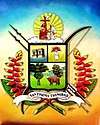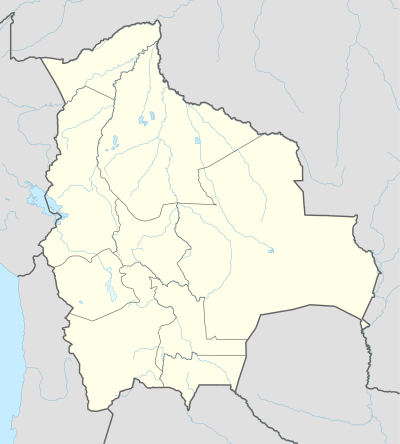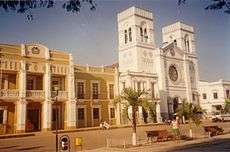Trinidad, Bolivia
Trinidad, officially La Santísima Trinidad (Spanish: The Most Holy Trinity), is a city in Bolivia, capital of the department of Beni. The population is 130,000 (2010 official estimate).
La Santísima Trinidad Trinidad | |
|---|---|
City | |
 | |
 Flag  Coat of arms | |
| Motto(s): "Green Trinidad" | |
 La Santísima Trinidad | |
| Coordinates: 14°49′45″S 64°54′5″W | |
| Country | Bolivia |
| Department | Beni |
| Province | Cercado |
| Founded | 1686 |
| Government | |
| • Mayor | Jorge Hurtado |
| Area | |
| • City | 27 km2 (10 sq mi) |
| Elevation | 130 m (427 ft) |
| Population (2012 Census) | |
| • Urban | 101,454 |
| Time zone | UTC-4 |
| Area code(s) | +591 346 |
| Climate | Am |
| Website | Official website |
- For other places and things named Trinidad, see Trinidad (disambiguation).
The city was founded in 1686 by Father Cipriano Barace. In 1769 the town moved to its current location, 9 miles away, due to flooding. The original city was on the Mamoré River, but flooding and disease forced a move on the location of the city. It is located in the province of Cercado, one of Beni’s eight provinces.
Sited on the southern edge of the Amazon basin on the Llanos de Moxos/Mojos, the climate is hot and humid at all times.
One of the more notable features of the city is the open drains that surrounds every block of buildings. These are linked together by lidded ditches and thence to the local river. These are necessary due to the heavy rainfall that occurs between December and May.
Trinidad, located in the Bolivian tropics, is hot and humid most of the year. This region of the country is heavily forested and many large rivers (all tributaries of the Amazon river) run through Beni. Like most cities in Bolivia, it is built around a central plaza with a large Catholic cathedral as its centerpiece. Trinidad was originally a small Jesuit town but is now a large city with over 100,000 inhabitants. Its mission-style church was demolished and rebuilt in 1923. Despite these changes, many of the original religious relics, paintings and statues are still housed in the cathedral, which faces the main plaza.
The City is surrounded by rivers, lakes and lagoons. There are many river tours and restaurants and resorts around the city’s main lagoons. Trinidad is also one of the first five Jesuit mission towns established and these are now part of the Misiones tour includes visits to San Javier, Loreto, San Pedro and San Ignacio de Moxos as well. Trinidad and San Ignacio de Moxos both take part in the International Baroque Music Festival every two years in Bolivia.
It is also home to Bolivian Navy flotilla.
Climate
Under the Köppen climate classification, Trinidad has a tropical monsoon climate with a lengthy rainy season and a short dry season.
| Climate data for Trinidad | |||||||||||||
|---|---|---|---|---|---|---|---|---|---|---|---|---|---|
| Month | Jan | Feb | Mar | Apr | May | Jun | Jul | Aug | Sep | Oct | Nov | Dec | Year |
| Record high °C (°F) | 37 (99) |
37 (99) |
37 (99) |
40 (104) |
42 (108) |
39 (102) |
38 (100) |
40 (104) |
37 (99) |
40 (104) |
38 (100) |
37 (99) |
42 (108) |
| Average high °C (°F) | 30.9 (87.6) |
30.8 (87.4) |
31.1 (88.0) |
30.6 (87.1) |
29.1 (84.4) |
28.4 (83.1) |
29.0 (84.2) |
30.8 (87.4) |
30.6 (87.1) |
32.6 (90.7) |
31.9 (89.4) |
31.4 (88.5) |
31.4 (88.5) |
| Daily mean °C (°F) | 26.9 (80.4) |
27.0 (80.6) |
27.1 (80.8) |
26.1 (79.0) |
24.5 (76.1) |
22.8 (73.0) |
22.6 (72.7) |
24.0 (75.2) |
24.7 (76.5) |
26.7 (80.1) |
26.9 (80.4) |
27.0 (80.6) |
25.5 (77.9) |
| Average low °C (°F) | 22.9 (73.2) |
23.2 (73.8) |
23.1 (73.6) |
21.6 (70.9) |
19.9 (67.8) |
17.1 (62.8) |
16.2 (61.2) |
17.2 (63.0) |
18.9 (66.0) |
20.9 (69.6) |
22.0 (71.6) |
22.6 (72.7) |
20.5 (68.9) |
| Record low °C (°F) | 15 (59) |
16 (61) |
13 (55) |
12 (54) |
8 (46) |
7 (45) |
3 (37) |
7 (45) |
10 (50) |
12 (54) |
12 (54) |
13 (55) |
3 (37) |
| Average precipitation mm (inches) | 298.9 (11.77) |
268.5 (10.57) |
225.5 (8.88) |
123.9 (4.88) |
114.6 (4.51) |
33.9 (1.33) |
32.1 (1.26) |
52.2 (2.06) |
123.3 (4.85) |
139.2 (5.48) |
226.8 (8.93) |
275.0 (10.83) |
1,913.9 (75.35) |
| Source 1: Sistema de Clasificación Bioclimática Mundial[1] | |||||||||||||
| Source 2: Weatherbase[2] | |||||||||||||
What to see
Trinidad has two singular museums. The Museo Itícola (Fish Fauna Museum) is the third largest of its kind in South America and houses over 400 specimens of fish species found in the region’s lakes and lagoons. It is located on the UAB University campus and is truly interesting. Here you can see tiny fish, piranhas, and a preserved pink river dolphin (full sized floating in formaldehyde). The Kenneth Lee Ethno-Archeological Museum is also a great place to visit. Here you can see exhibits of pottery, utensils and tools, textiles and other implements used by the Moxos culture.
Of interest to ornithologists, the highly endangered blue-throated macaw (Ara glaucogularis) in the surrounding countryside. Expeditions to see these can be locally arranged.
Transportation
Airport: (IATA: TDD, ICAO: SLTR) Teniente Jorge Henrich Arauz
- Lat: 14° 48' 0 S
- Lon: 64° 46' 0 W
- Alt: 509 feet (155 metres)
Gallery
- Trinidad Cathedral, in Bolivia
 Ibaré River, Beni
Ibaré River, Beni Square in Trinidad, Bolivia
Square in Trinidad, Bolivia- Monument in Trinidad
 Trinidad Cathedral
Trinidad Cathedral Trinidad, Bolivia
Trinidad, Bolivia
References
- "Bolivia- Trinidad" (in Spanish). Centro de Investigaciones Fitosociológicas. Retrieved December 24, 2012.
- "Weatherbase: Historical Weather for Trinidad, Bolivia". Weatherbase. Retrieved December 24, 2012.
External links
| Wikimedia Commons has media related to Trinidad, Bolivia. |
